The Japanese Giant Salamander
Introduction
The Giant Salamander is an amphibianamphibian and is one of the largest lizards in the CryptobranchidaeCryptobranchidae family. Its cousin is the newt and there are other giant salamanders in China and the United States.Distribution of Japanese Giant Salamander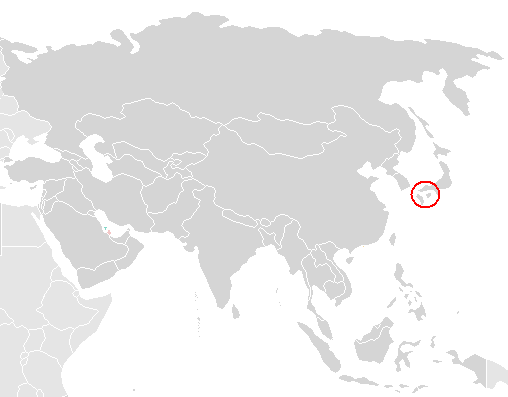
Habitat
In Japan, the Giant Salamander lives in cold, fast-flowing mountain streams with rocky bottoms on the islands of KyushuKyushu and Honshu.Honshu.
Appearance
The Japanese Giant Salamander can weigh up to 20kg and grow to the lenth of 40-70cm. Some can grow to 140cm. To camouflage on the bottom of rocky streams, their dark brown skin has black 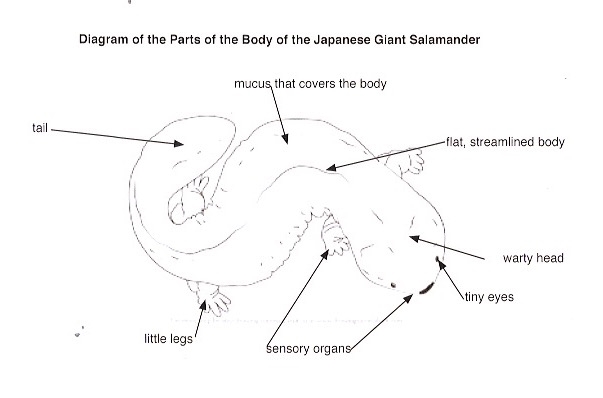 spots. On their head they have warty skin. Most of the species of salamander have no legs but the Japanese Giant Salamander have legs which they don’t use much. They have a pepper smelling mucusmucus that protects them from predators and from getting scratched and bruisedbruised against the rocks. The lubricantlubricant helps them swim elegantlyelegantly through the water, along with their flat bodies. Because the Japanese salamander have tiny eyes, they have poor vision.vision. They use their sensorysensory organsorgans on their bodies and head to get food at night.
spots. On their head they have warty skin. Most of the species of salamander have no legs but the Japanese Giant Salamander have legs which they don’t use much. They have a pepper smelling mucusmucus that protects them from predators and from getting scratched and bruisedbruised against the rocks. The lubricantlubricant helps them swim elegantlyelegantly through the water, along with their flat bodies. Because the Japanese salamander have tiny eyes, they have poor vision.vision. They use their sensorysensory organsorgans on their bodies and head to get food at night.
Diet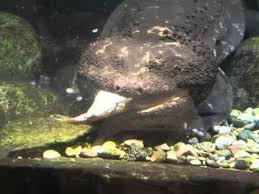 This hungry salamander is eating a fish.Its diet includes worms, insects, crabs, fish, frogs and mice. A slow metabolismmetabolism means they can go for weeks without food.
This hungry salamander is eating a fish.Its diet includes worms, insects, crabs, fish, frogs and mice. A slow metabolismmetabolism means they can go for weeks without food.
Life Cycle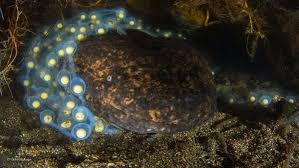 The female salamander lays her eggs.Its breeding age is at five to ten years. At breeding time the males turn a brighter colour to attract the females. In autumn in late August, the females lay 500 – 600 eggs. The males guard the nest. While guarding the nest, the males fight and some even die. After 40 to 50 days, the eggs hatch.
The female salamander lays her eggs.Its breeding age is at five to ten years. At breeding time the males turn a brighter colour to attract the females. In autumn in late August, the females lay 500 – 600 eggs. The males guard the nest. While guarding the nest, the males fight and some even die. After 40 to 50 days, the eggs hatch.
Enemies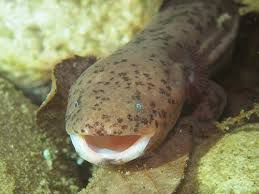 Its brown speckles helps the giant salamander hide in the rocky streams.The Giant Salamander have no natural predators but they are listed on the
Its brown speckles helps the giant salamander hide in the rocky streams.The Giant Salamander have no natural predators but they are listed on the
Endangered List mainly because of habitathabitat loss and pollution. They can be susceptiblesusceptible to some fungusfungi in the water.
Conclusion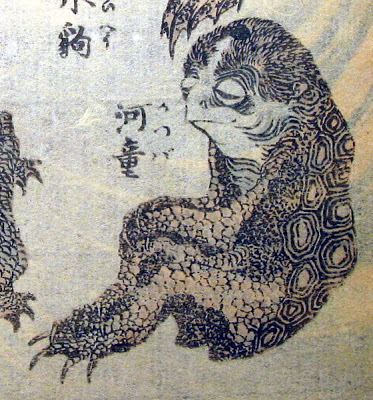 The kappa is a bogeyman to frighten children in Japan that looks a lot like the salamander.The Japanese Giant Salamander is an important creature because there are not many left in Japan. Their habitat - cold, fast-flowing mountain streams - are being destroyed by deforestationdeforestation and pollution. They have poor vision but have sensory organs to help them find the crabs and insects that they eat. An unusual fact about the giant salamander is that the male guards the rest.
The kappa is a bogeyman to frighten children in Japan that looks a lot like the salamander.The Japanese Giant Salamander is an important creature because there are not many left in Japan. Their habitat - cold, fast-flowing mountain streams - are being destroyed by deforestationdeforestation and pollution. They have poor vision but have sensory organs to help them find the crabs and insects that they eat. An unusual fact about the giant salamander is that the male guards the rest.
Glossary
| amphibian | a cold blooded vertebrate that can live in water and on land | metabolism | all chemical reations that keep an organism and its cells alive |
| bogeyman | a monster that parents invent to scare children into behaving themselves | mucus | a slimy substance |
| fungi | a group of organisms that include yeasts, molds and mushrooms | sensory organs | organs that help an organism sense things eg eyes and ears |
| habitat | where an organism lives | susceptile | likely to be harmed by something |
| lubricant | something oily or slimy that helps things move | vision | the sense of sight |
Bibliography
Animal Encyclopedia - Animals of the World by Tom Jackson, published by Lorenzo Books in 2008
Smithsonian National Zoo Website
By Ruby
{chronoconnectivity5}L2L_NF2_Feedback{/chronoconnectivity5}